A single connection can change everything. What began as a short visit to Nepal has blossomed into a lifelong friendship and professional alliance. It’s a story of courage, compassion and grit. Dr. Raju Dhakal, M.D., is Medical Director and Physiatry Consultant Physician at the Spinal Injury Rehabilitation Centre near Kathmandu, Nepal. Couple Peter Wing and Claire Weeks are retired Vancouver physicians. Dr. Wing, M.D., FRCSC, is a UBC Clinical Professor Emeritus of Orthopaedics and former spine surgeon. Dr. Weeks is a UBC Clinical Assistant Professor Emerita, physiatrist and spinal cord rehab specialist.
The pair first met Dr. Raju in 2009 on a two-week trip to help the new director of the spinal cord injury hospital outside Kathmandu seeking to further his training in the rehabilitation of people with spinal cord injury (SCI). In the early days of that facility, 50 to 80 percent of patients died while in care. Drs. Weeks and Wing soon realized Dr. Raju would require more advanced training. The couple became Dr. Raju’s sponsors and mentors. Today, Dr. Raju is Nepal’s one and only Physical Medicine & Rehabilitation (PM&R) specialist. Through storms, earthquakes, flooding and a global pandemic, their collective efforts have improved the lives of hundreds… Here are their stories.

Drs. Raju Dhakal (middle) and Peter Wing (second from right) at Tribhuvan University Teaching Hospital in 2009. Chief of service Dr. Dinesh Kafle (far left) with two orthopedic residents. On Drs. Wing and Claire Weeks' first visit to Kathmandu, they arranged visits at a few of the major trauma hospitals referring patients to the Spinal Injury Rehabilitation Centre (photo: Peter Wing)
Dr. Raju’s story
What would I be doing now if I had not joined the family at Kathmandu’s SOS Children’s Village? Would I be known as Dr. Raju? Would my physical condition be as good as it is today? Could I have ever imagined my professional status and international recognition, my lovely wife and beautiful daughter, the loving SOS brothers and sisters, my home, and the tireless encouragement and guidance I’ve had? I still remember that day in 1988 when I first saw youngsters like me playing together in a modern, homey environment...
Back home in Jaubari, Gorkha, I was a playful and curious toddler, the youngest with four older sisters. Ours was a remote village, a day’s trek on rough trails to start the eight-hour bus ride to Kathmandu. One hot summer day when I was two, I played longer than the usual with clay, mud and stones in the yard. Later that evening, I came down with a high fever and diarrhea. I lost consciousness and my whole body became paralyzed. There were no doctors, hospitals, roads, electricity or vaccines available, so my family relied on local faith healers. But to no avail. My family sent me to Kathmandu for treatment, but doctors at several hospitals told us it was too late: I had polio and would never be able to use my legs again.
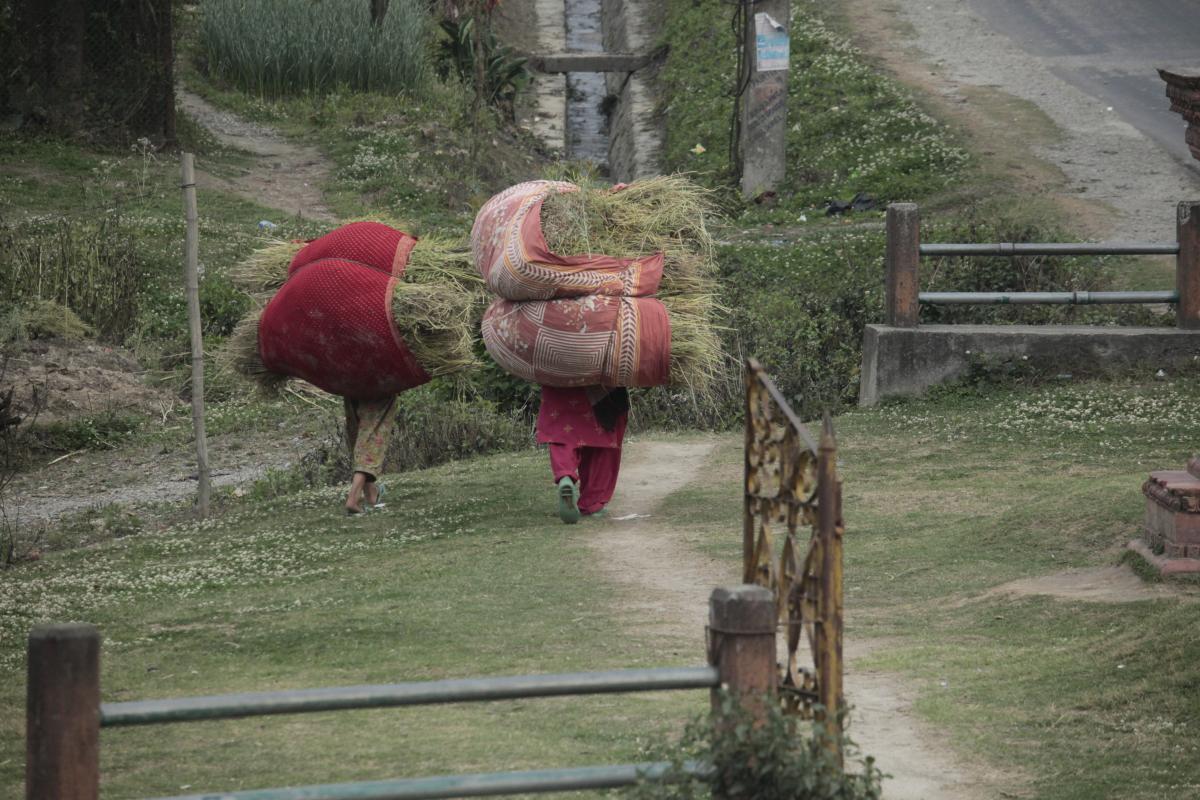
Much of the heavy work on Nepal's subsistence farms is done by women (photo: Peter Wing, 2012)
Returning home, I spent the next six years with crippling paralysis, crawling around with no rehabilitation, no assistive devices and no real participation in the community. Schooling was not possible because of inaccessibility. Some even said my condition was punishment for “sins committed in a past life.”
My great fortune, and the turning point of my life, was because some relatives knew about SOS Children’s Village. I joined the Village family in 1990 and could finally attend school. After three operations and extensive rehabilitation, by 1991 I was finally able to walk with calipers and elbow crutches – the first time in years off the floor! I even forgot I had a disability. There, I learned to love and to be loved in a family. I graduated from high school at the top of my class. It was truly my first great step towards a quality higher education.
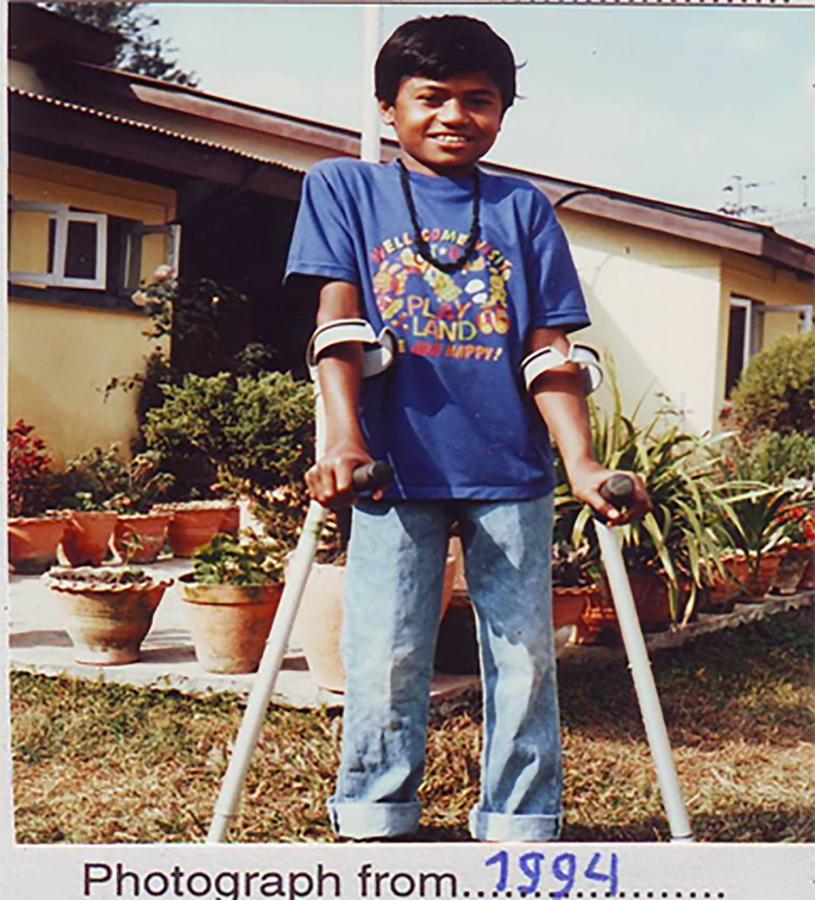
Raju Dhakal at the SOS Children's Village in Jorpati, Kathmandu in 1994 (photo: Raju Dhakal)
College life was different – and difficult. It was the first time I was living alone without my SOS family, bearing all the responsibility of cooking and washing. There was no accessible infrastructure to speak of for people with restricted mobility. And it was a huge challenge to run into so many hurdles while feeling so homesick. In spite of struggling with every aspect of life there, with the support of new friends and great motivation from my devoted teachers, I passed the Higher Secondary Board exam in the first division.
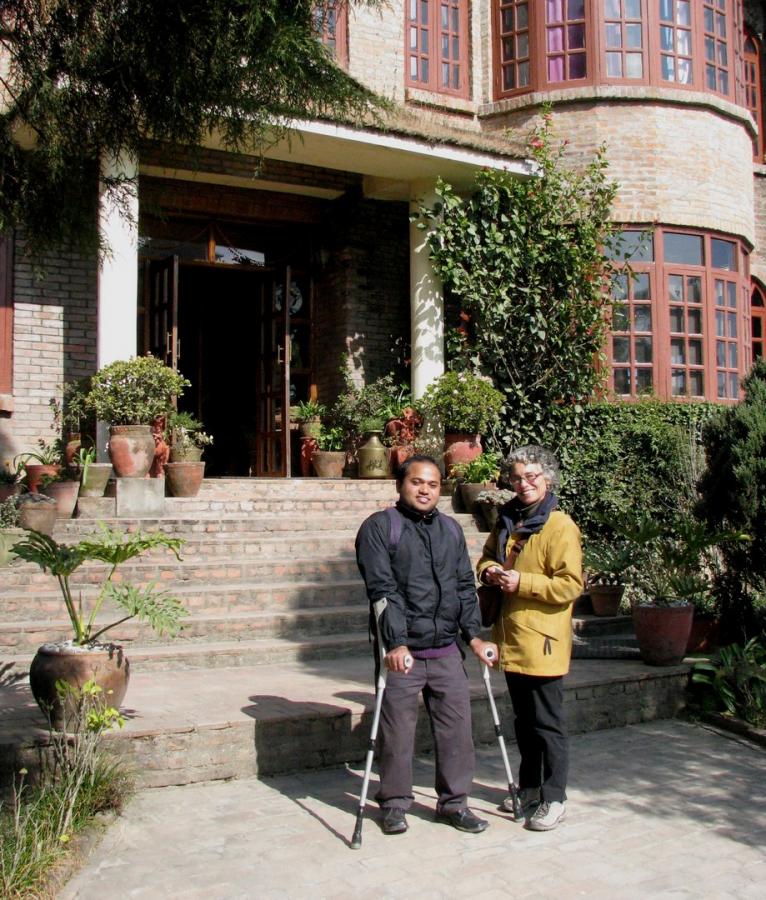
Drs. Raju and Claire Weeks in Nagarkot on their first trip in 2009 (photo: Peter Wing)
But there was another great challenge ahead, and a single decision changed the direction of the rest of my life. Deep down, I had a passionate interest in studying for a Bachelor of Medicine and Bachelor of Surgery. I wanted to be a doctor. I knew that every year more than 100 SOS children qualify for higher study. Medicine was often their first choice. Some of them might have been smarter or had higher exam scores than I did. But at that time, SOS believed in my ability, not my disability – and that resonated profoundly with me.
Since that time, I have always tried to conduct myself in a way that makes me more responsible, honest, loyal and committed towards my aims and the investment of my Village in the truest sense. I finished my medical degree with good marks – the only student in Nepal with a physical disability since childhood to study medicine. And even my presence in the medical college was a source of inspiration for others. I made so many good friends, took part in every social activity and even won three gold medals in table tennis competing with my non-disabled friends! Every time, all my friends cheered for my victory and success. I felt that, at every step, victory was just waiting to kiss me. All this happened in my college life just because I had already overcome so many barriers. I learned to celebrate my ability, but never complain.

Dr. Raju surprises his ablebodied opponent in an informal game of table tennis in the inner courtyard of the Changu Narayan temple, considered to be Nepal's oldest (photo: Peter Wing, 2009)
During my rotations in medical school, I sensed something was missing in health care. Later on, I realized it was rehabilitation. From the very beginning, I was interested not only in curative medicine, but also in the preventive, diagnostic and rehabilitative aspects. I saw many patients with spinal cord injuries and disorders, brain injuries and polytrauma lying in bed, suffering avoidable complications. Too often, they died prematurely. And there was not a single rehabilitation physician in Nepal to manage their issues.
This was the driving force for me to become that person. Along the way, Drs. Peter Wing and Claire Weeks have been a source of inspiration both personally and in my professional career. With the help of SpiNepal contributors, in collaboration with Spinal Injury Sangh Nepal and UBC, they supported me throughout my PM&R residency, and showed me the field of spinal cord injury medicine and rehabilitation. They were available to talk whenever I needed them; sometimes as colleagues, sometimes as guardians. Before every exam, they called me to discuss, spoke to my professors on my behalf, and connected me with other professionals from around the world. Drs. Wing and Weeks care deeply about me and my wife Sheela, and I know what I’ve accomplished would not have been possible without their mentorship and the support of UBC.

Dr. Raju and future wife Sheela relaxing together in 2010 (photo: Peter Wing)
Today, I am Nepal’s first – and still only – registered PM&R physician. I vowed to put 100 percent effort into my profession, and like Drs. Wing and Weeks, be an agent of change. I know there are many MDs who can diagnose a patient’s condition and prescribe medicine accordingly, but I wanted to go well beyond that.
I started at the Spinal Injury Rehabilitation Centre near Kathmandu in 2009 as the only physician. It is a 51-bed, non-profit in- and out-patient facility opened in 2002, the only one in the country specializing in spinal cord injury. For some 350 patients a year, our staff of 75 takes a holistic, comprehensive and interdisciplinary approach – with medical doctors, diagnostic facilities, physiotherapy, occupational therapy, nursing care, psychology, social service, peer counseling, recreational and sports activities, vocational training, wheelchair maintenance and an orthotic workshop, all under one roof.
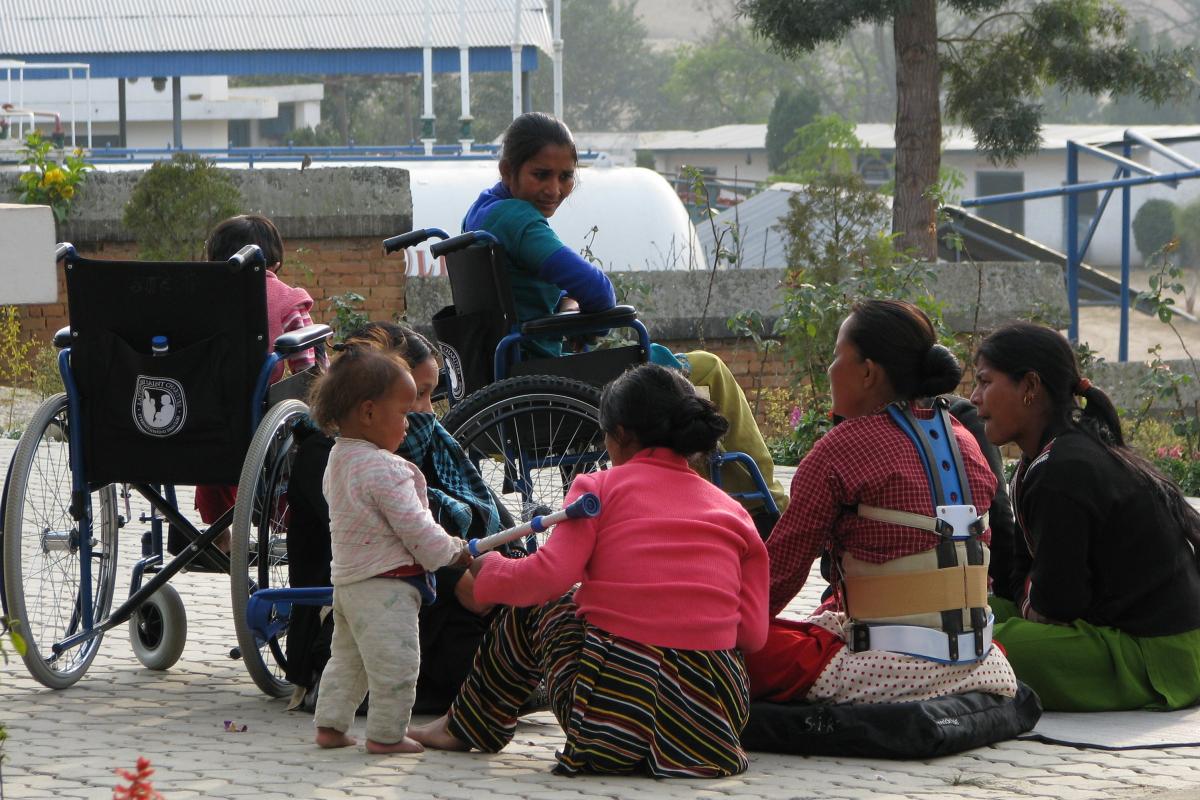
Female patients and caregivers gather in front of SIRC in 2009 (photo: Peter Wing/SIRC)
My career has been very rewarding in many ways. I am in charge of the Centre’s many interesting patients, often with challenging problems, helping them adapt from the life-changing injury to their spinal cord, from stroke and other conditions.
Working with the Nepal government, I was the team lead and expert in developing a training manual addressing “Post-acute Care and Rehabilitation of Patients with Spinal Cord Injury.” We have used this as the foundation of our workshops for health care professionals in hospitals without rehabilitation services. Now, we are seeking ways to support the development of specialized rehab facilities in other major centres that can network with ours. I would like to see these with training programs in each of Nepal’s seven provinces.
Over the years, I’ve joined many research projects, collaborated with global teams, and presented at national and international conferences. The future is promising. I expect to be an active participant in developing governance and leadership as we shape national policies for the care of spinal cord injury and the training programs to give them meaningful lives.
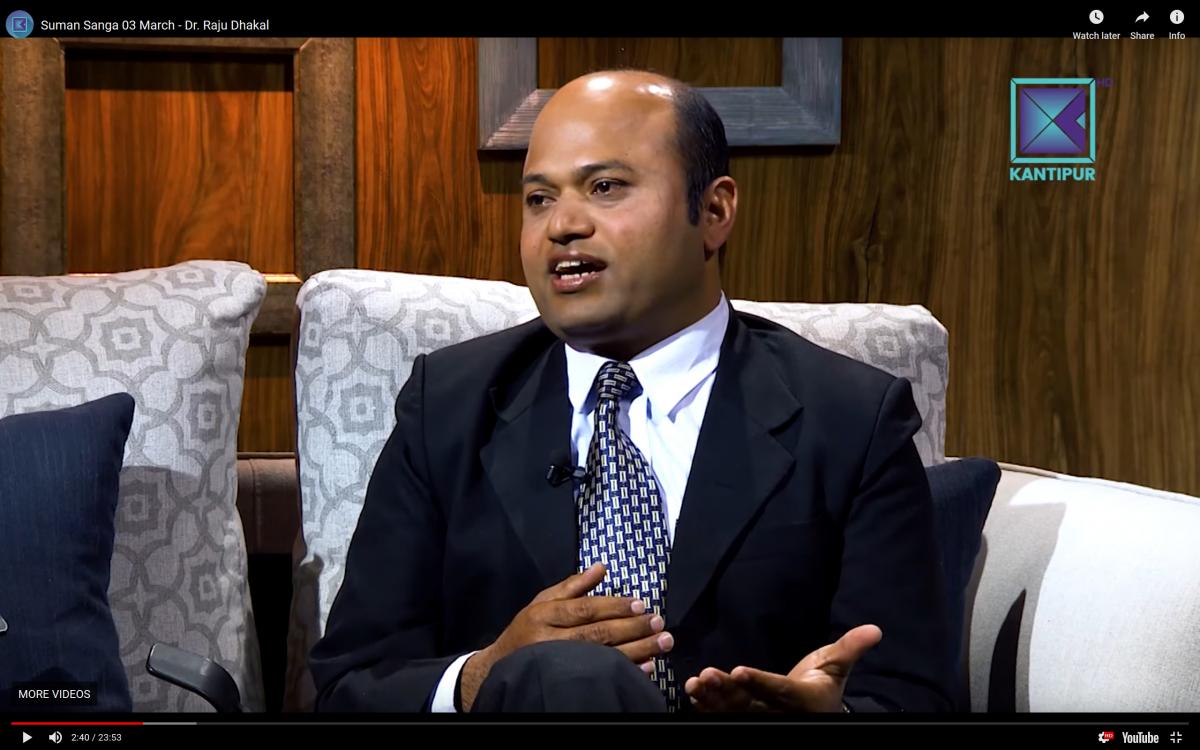
Dr. Raju discusses rehabilitation with host Suman Kharel on the Kantipur TV Suman Sanga program in 2018 (photo: Raju Dhakal)
And – I am able to give back. I am on the board of the Spinal Cord Injury Network, which operates two residences in Kathmandu for kids with spinal cord injuries, who, like me, lived too remotely to be able to attend school. They spend school terms in Kathmandu furthering their education – and thriving. Seeing these kids flourish is truly one of my life’s greatest joys.
Read more about Dr. Raju’s impactful work.
Find out more about Nepal’s Spinal Injury Rehabilitation Centre.
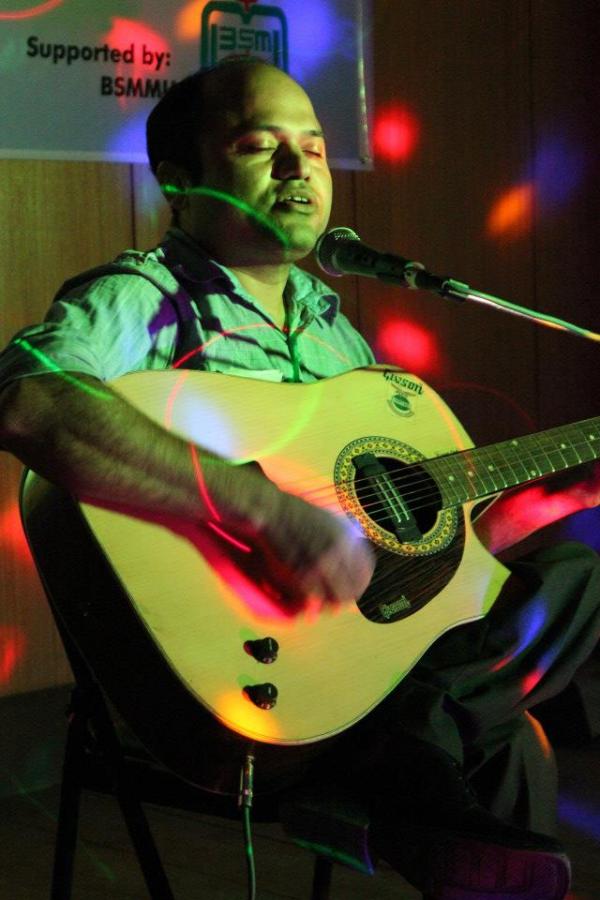
Dr. Raju performing live in Dhaka to welcome a new foreign MD and MS senior resident at BSMMU, Dr. Raju's university in Dhaka (photo: Raju Dhakal)
Dr. Wing and Dr. Weeks’ story
Late one dark November night in 2009 found us transported along eerily illuminated, increasingly deserted and potholed Kathmandu streets to a large, apparently impregnable locked gate in Kathmandu’s Jorpati district. We didn’t know that we were at the compound of the Nepal Orthopaedic Hospital, also site of the SOS Children’s Village and former home of the Spinal Injury Rehabilitation Centre, manned by a gun-toting soldier on top. Instead of street lights, fires were burning everywhere. We wondered, what we had gotten ourselves into. It turned out we were about to embark on an adventure more far-reaching than we could ever have anticipated. And now, 12 years later, this place has become a second home to us.
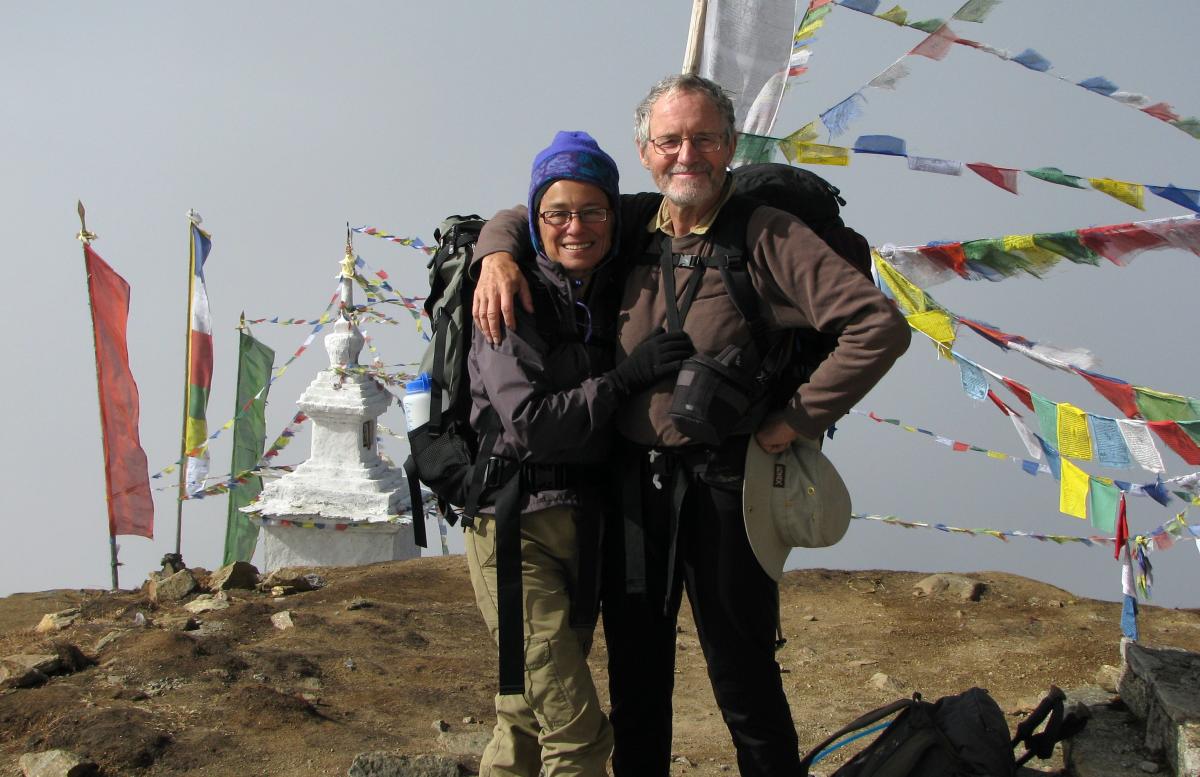
The couple returns from a trek to Langtang Valley, Nepal, next to prayer flags near Gosainkund, in 2010 (photo: Peter Wing and Claire Weeks)
We had been active members of the International Spinal Cord Society and its Education Committee for years. The stark contrast between outcomes for people with spinal cord injury in better- and lesser-resourced countries sparked our interest in pursuing international work after retirement (spinal cord injury rehab for Claire; orthopaedic spine surgery for Peter). We had enthusiastically accepted a request to spend a couple of weeks teaching a young doctor recently hired to work at the Spinal Injury Rehabilitation Centre near Kathmandu.
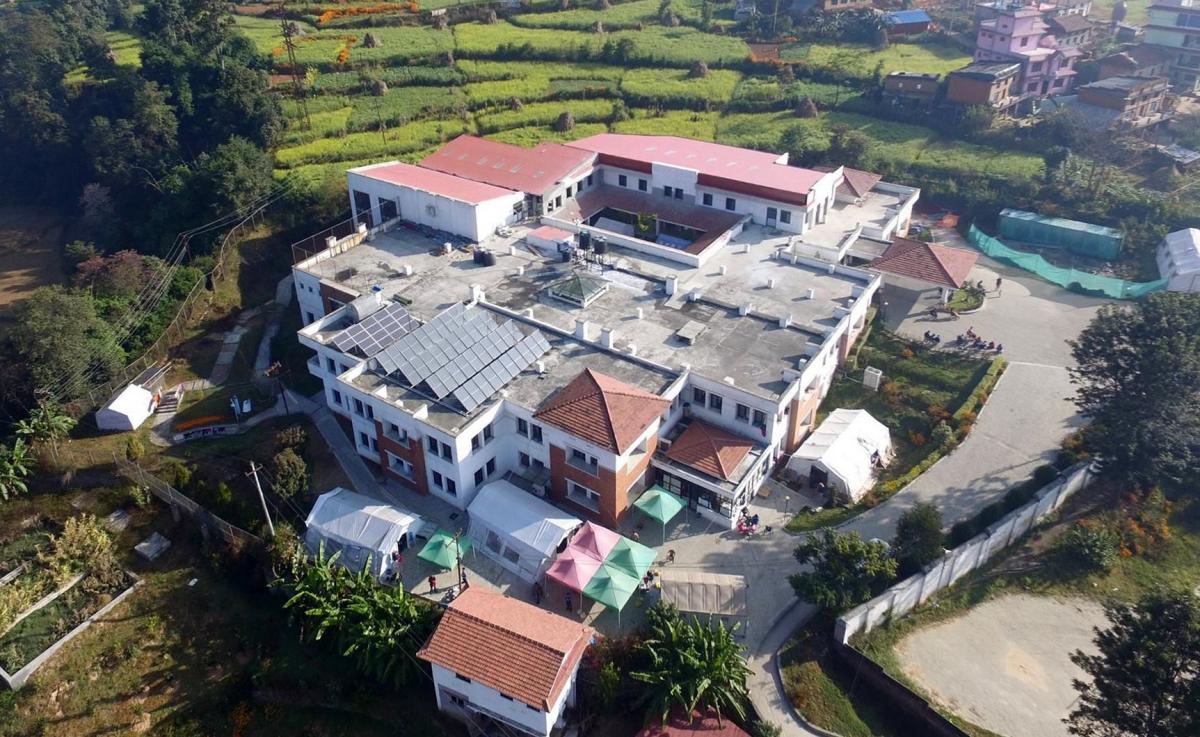
The Centre in 2015, with building additions and remaining tents following the April 2015 earthquake (photo: Narayan Shrestha/SIRC)
When we first visited in 2009, the newly-occupied, well-designed, earthquake-resistant rehab centre was operating at about 60 percent occupancy of its 50 beds. Since inception, the organization had been staffed by mostly aide-level physiotherapists, occupational therapists, nurses, a social worker and others, and with only occasional consultation with a physician. A dedicated physician was not available, and rehabilitation medicine and spinal cord injury education was not available at all in Nepal. Morbidity remained high, with pressure sores mostly arising due to deficiencies in prehospital and acute care. Aware of this problem, the organization had just brought on Dr. Raju Dhakal (“Dr. Raju,” following the Nepalese convention).
A paraplegic from childhood polio, Dr. Raju proved to be a hard-working, energetic and enthusiastic recent medical school grad, the first disabled person in Nepal to earn that title. Dr. Raju absorbed information like a thirsty sponge. The Centre had made a good choice, but Dr. Raju needed more education and skills training than we could hope to provide by annual trips of short duration. Training of other staff was supported by regular multidisciplinary team visits from the excellent Swiss Paraplegic Centre, and we wondered how we might help. We decided to close a huge gap and support training for a physician leader.
To become the country’s first rehab specialist, Dr Raju wanted to complete residency training in PM&R. Comparisons of rehab medicine residencies in Canada and the West with those in Asian centres led to Dr. Raju’s choice of the five-year program in Dhaka, at the Bangabandhu Sheikh Mujib Medical University. We supported this decision and offered to sponsor him – a decision we have not regretted for a moment.

Dr. Raju in the prosthetics lab at the Australia's Royal Melbourne Hospital, where he was Professor Fary Khan's guest in September 2015 for two weeks (photo: Raju Dhakal)
And so, we had found our niche: supporting development of specialist medical and surgical management for those with spinal cord injuries. (We also supported Dr. Prakash Paudel through his neurosurgical and spine surgery training.) Our focus was on training and mentoring. What began as a two-week teaching session evolved into the nonprofit Spinal Cord Injury Collaboration (SpiNepal), operating within the UBC Development Office for most of its 10 years. Dr. Raju excelled in his PM&R training program and became one of the rare Nepali candidates to pass the fellowship qualifying exams on his first try.
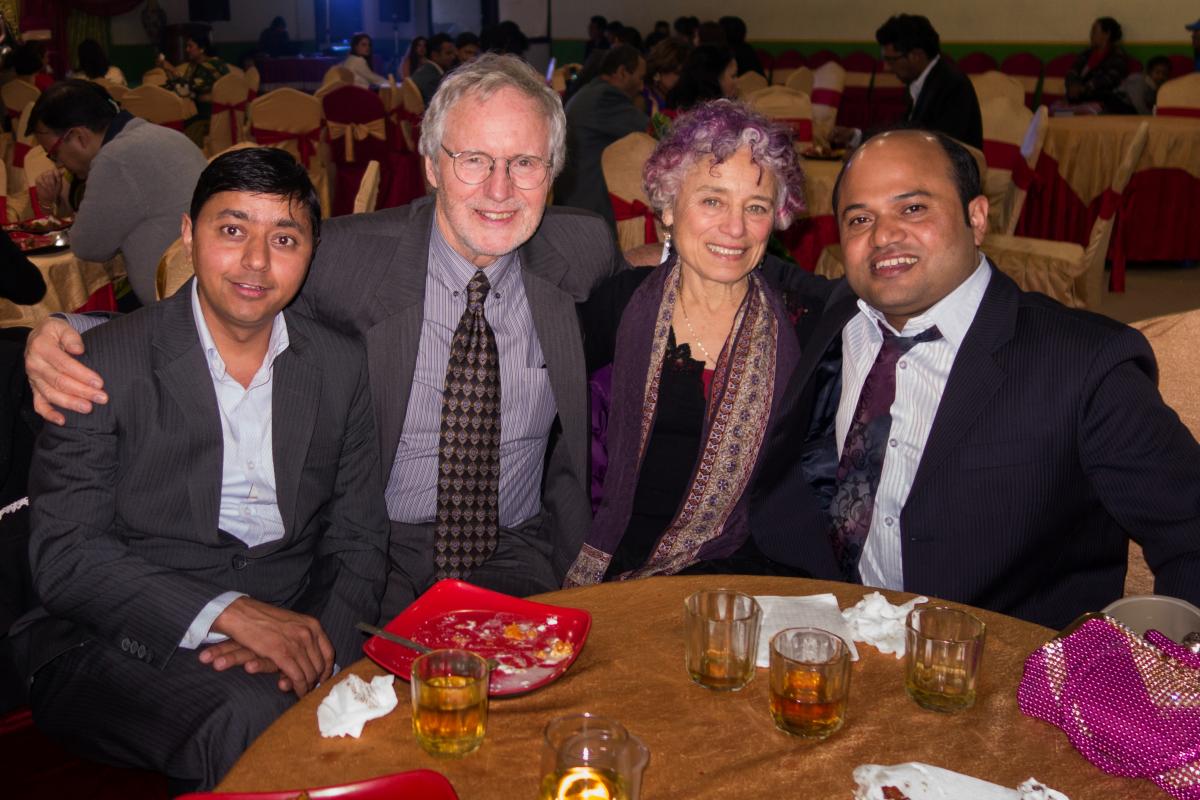
From left: Drs. Prakash Paudel, Peter Wing, Claire Weeks and Raju Dhakal at the 2015 Asian Spinal Cord Network conference dinner (photo: Peter Wing and Claire Weeks)
The costs to SpiNepal? Tuition and manageable cost-of-living stipends, with additional travel expenses for observerships, and to attend meetings and workshops. Nathan O’Hara, then a logistician working in UBC Orthopaedics, helped us establish our web presence and financial management through UBC. The university’s tremendous support means that we can reassure our supporters that 100 percent of the donations provide support to the trainees – we have covered our own costs when we visit Nepal.
There have been challenges along the way, the most tragic being Nepal’s April 2015 earthquake, which killed 9,000, injured 21,000 and rendered 3.5 million homeless. Some of the rehab team consulted at the trauma hospital for the first few days until admissions could be arranged; 27 people with spinal cord injuries were received in the first week. As soon as the airport could be reopened, Dr. Raju flew home with a medical team he had assembled in Bangladesh. SpiNepal was able to quickly raise substantial funds to support these activities.
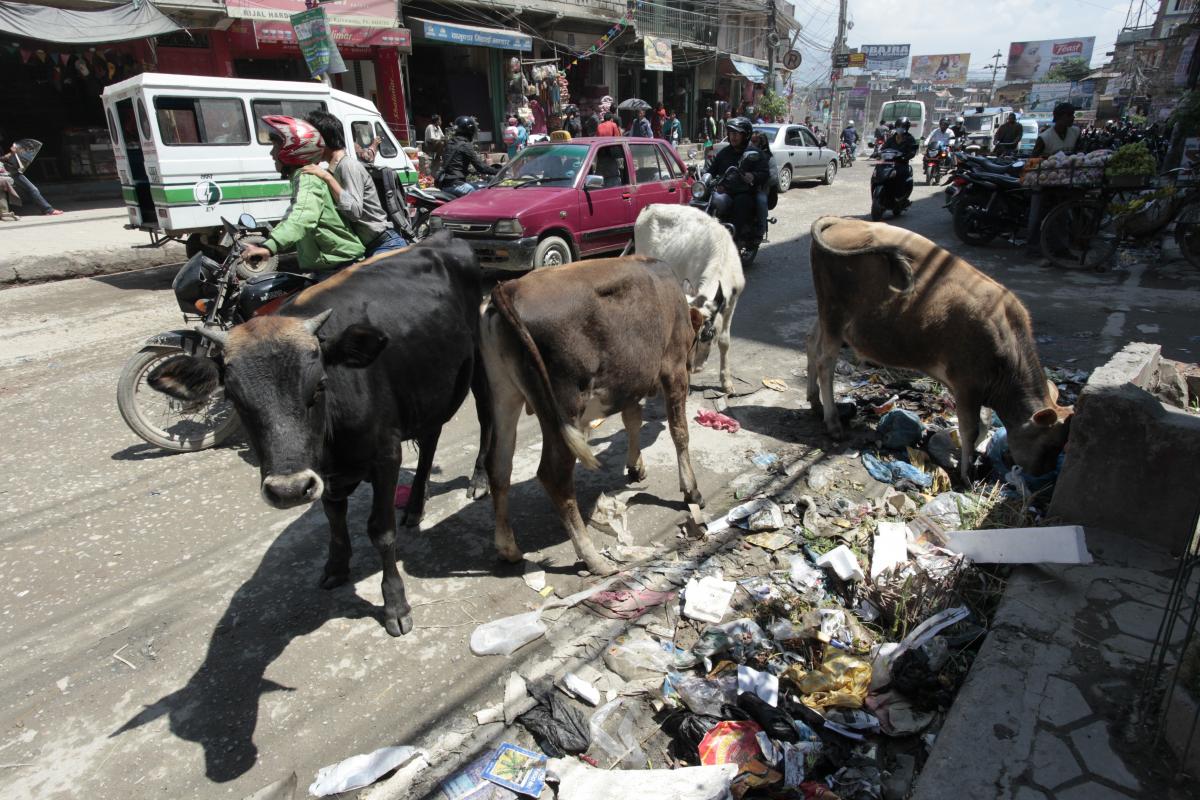
Holy cows in a typical Kathmandu street scene: in Jorpati, Kathmandu in 2012, prior to the earthquake (photo: Peter Wing)
With Dr. Raju, we devised an efficient way to support the Centre by connecting him by phone and Skype with us and a number of our colleagues to discuss urgent cases as they were admitted, supporting them with perhaps the earliest foreign consultations. Within a few weeks, foreign medical teams began arriving to help on the ground, but our e-consultations continued for some time. Working with other groups, the rehab centre admitted 117 people with spinal cord injuries caused by the earthquake, more than doubling its capacity! In the end, this approach proved effective preparation for the COVID-19 pandemic to come.
Dr. Raju’s residency training in Bangladesh had to be supplemented with more clinical exposure in some areas, especially spinal cord injury. To achieve this, we (SpiNepal) and others arranged for him to take part in a number of observerships, including one in Vancouver and one in Toronto Rehab in 2016. A colleague with the Canadian Association of Physical Medicine & Rehabilitation sponsored Dr. Raju to take the intensive one-week rehab review course for Canadian PMR residents coming up to their final Fellowship exams, which likely contributed to his passing the final specialty exam. The Swiss Paraplegic Centre hosted the entire rehab team for a month of training as well. There’s no doubt that the extra exposure Dr. Raju got contributed greatly to the clinical expertise he now brings to his patients.
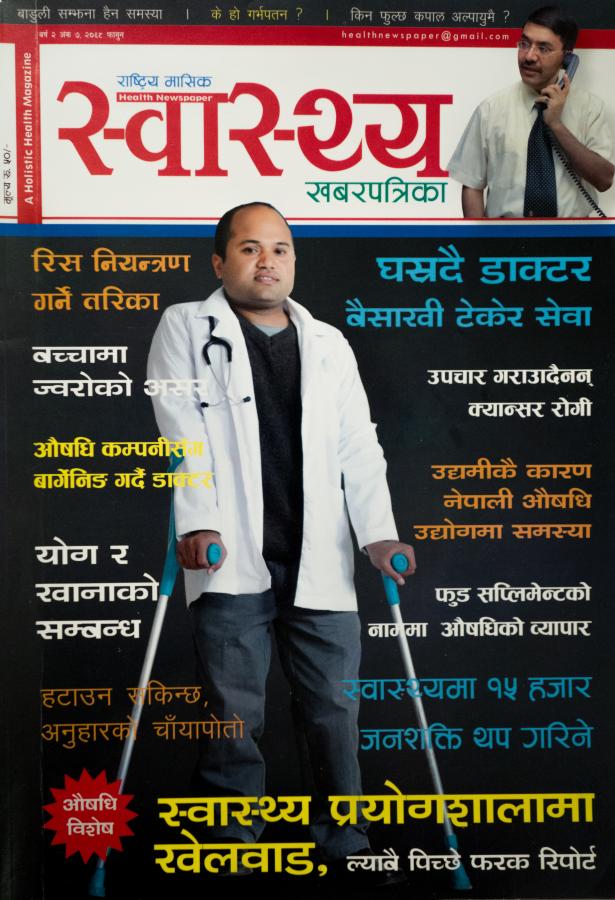
Magazine cover featuring new medical graduate Dr. Raju Dhakal, Nepal's first disabled medical school graduate (photo: Peter Wing, 2013)
Our relationship with Dr. Raju, as we get further and further from clinical work in retirement, has evolved. Having started with a two-week commitment to teach him, we became regular teachers to him and the hospital staff, workshop organizers and advisors on various subjects. We took on mentorship roles which broadened over the years, but we now see ourselves mostly as peer-colleagues… and as friends and family.
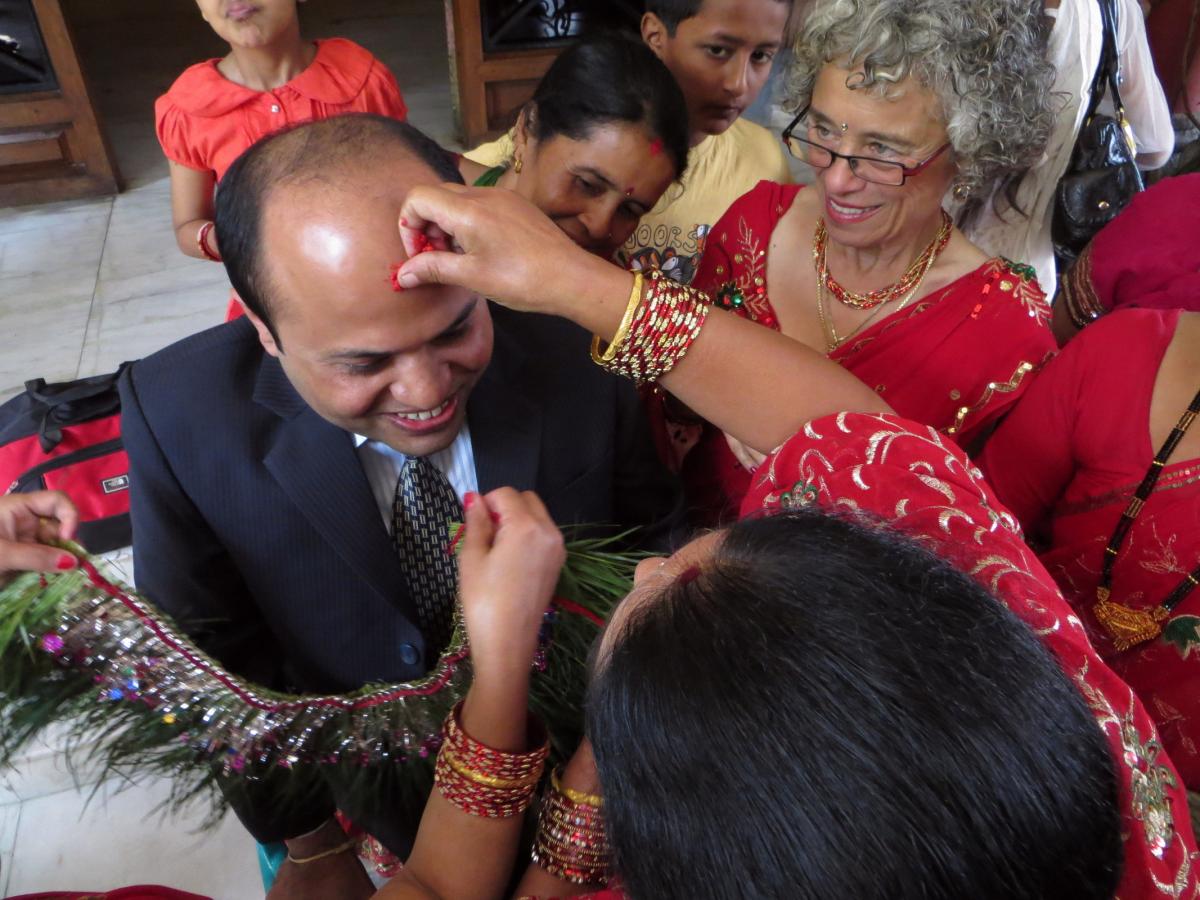
Dr. Raju and his sister Kamala on his wedding day in 2012 with Claire Weeks on the right (photo: Peter Wing)
We are delighted by the clinical and administrative work Dr. Raju has done, the challenges he has met with aplomb, the respect he has gained in the professional world and with the government, the pleasure he derives from his family life. We have learned far more than we taught – and are pleased to think that we have initiated a meaningful difference in the lives of Nepalese people who have sustained spinal cord injuries.
Read about SpiNepal and how to support the Spinal Cord Injury Collaboration.
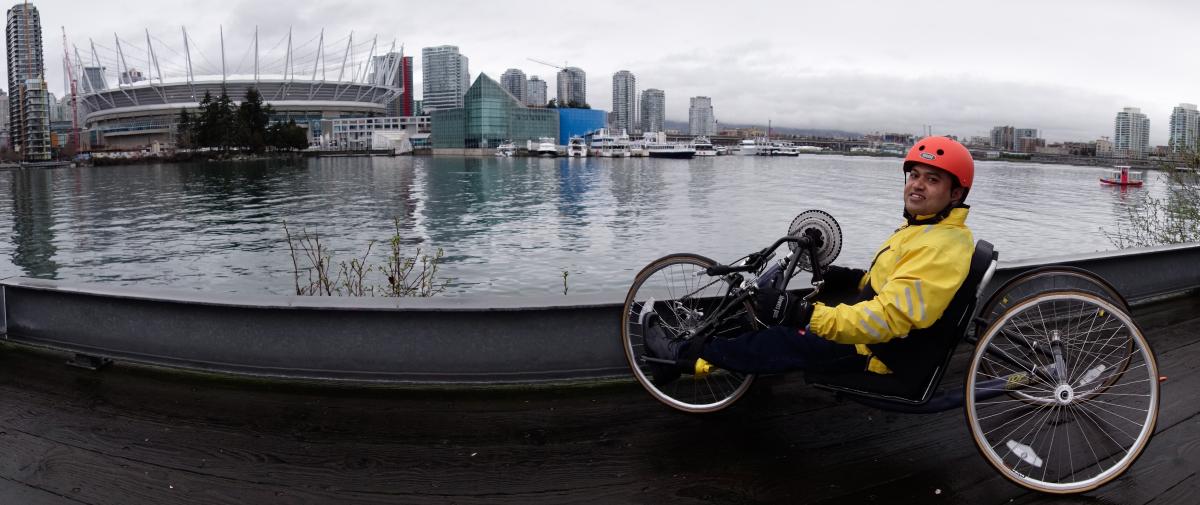
Dr. Raju, visiting Canada in 2016, tries his skill on a handcycle in Vancouver. He attended a resident review course in Toronto and toured two rehab hospitals, including Vancouver's GF Strong (photo: Peter Wing)
